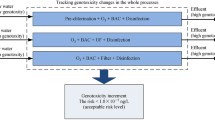Abstract
Surface waters adjacent to a nuclear fuel processing facility were extracted, using XAD-resin adsorption followed by solvent elution, and the extracts were assayed for mutagenic potential by the AmesSalmonella-mammalian microsome test. Dose-related mutagenic responses with TA102 (+ S9) were produced with the extracts of water samples obtained from a creek receiving waste-water from the processing facility (specific mutagenic activities of 7,250 to 8,250 net revertants per L equivalent of water). The creek water extracts were not mutagenic with TA102 in the absence of S9, or with any other tester strain (i.e., TA97, TA98, TA100, and TA1535) in the presence or absence of S9. Surface water samples downstream and upstream of this creek were not mutagenic; apparently indicating the lack of persistence of the observed mutagenicity. The major constituent in the mutagenic creek water extracts was identified as tributylphosphate (TBP) by gas chromatography-mass spectrometry. However, TBP was not mutagenic with TA102 (+ S9) at doses ranging from 196 μg/plate to 9.8 ng/plate. Because tester strain TA102 detects oxidative mutagenesis due to x-rays and ultraviolet radiation, it is possible that the observed mutagenicity of creek water extracts was due to radionuclides complexed to TBP.
Similar content being viewed by others
References
Batzinger RP, Ou S-YL, Bueding E (1978) Antimutagenic effects of 2(3)-tert-butyl-4-hydroxyanisole and of antimicrobial agents. Cancer Res 38:4478–4485
Blevins RD, Schreiber JC, Pancorbo OC (1985) Gross alpha and beta radioactivities associated with aquatic environments of upper-east Tennessee impacted by industrial and mining activities. Arch Environ Contam Toxicol 14:83–88
Brown KW, Donnelly KC (1984) Mutagenic activity of the liquid waste from the production of acetonitrile. Bull Environ Contam Toxicol 32:742–748
Donnelly KC, Brown KW, Thomas JC, Davol P, Scott BR, Kampbell D (1985) Evaluation of the hazardous characteristics of two petroleum wastes. Hazardous Waste and Hazardous Materials 2:191–208
Dressler M (1979) Extraction of trace amounts of organic compounds from water with porous organic polymers. J Chromatogr 165:167–206
Ellis DD, Jone CM, Larson RA, Schaeffer DJ (1982) Organic constituents of mutagenic secondary effluents from wastewater treatment plants. Arch Environ Contam Toxicol 11:373–382
Fallon RD, Fliermans CB (1980) Formation of non-volatile mutagens by water chlorination: Persistence and relationship to molecular weight of organic material in water. Chemosphere 9:385–391
Heartlein MW, DeMarini DM, Katz AJ, Means JC, Plewa MJ, Brockman HE (1981) Mutagenicity of municipal water obtained from an agricultural area. Environ Mutagenesis 3:519–530
Honer WG, Ashwood-Smith MJ, Warby C (1980) Mutagenic activity of swimming-pool water. Mutat Res 78:137–144
Levin DE, Hollstein M, Christman MF, Schwiers EA, Ames BN (1982) A newSalmonella tester strain (TA102) with A T base pairs at the site of mutation detects oxidative mutagens. Proc Natl Acad Sci 79:7445–7449
Loper JC (1980) Mutagenic effects of organic compounds in drinking water. Mutat Res 76:241–268
Maron DM, Ames BN (1983) Revised methods for theSalmonella mutagenicity test. Mutat Res 113:173–215
Maruoka S, Yamanaka S (1982) Mutagenicity inSalmonella typhimurium tester strains of XAD-2-ether extract recovered from Katsura River water in Kyoto City, and its fractions. Mutat Res 102:13–26
— (1983) Comparative studies using the AmesSalmonella/microsome test on mutagenicity of the XAD extract recovred from the river waters in Kyoto City. Environ Sci Technol 17:177–180
Meier JR, Bishop DF (1985) Evaluation of conventional treatment processes for removal of mutagenic activity from municipal wastewaters. J Water Pollut Control Fed 57:999–1005
Metcalfe CD, Sonstegard RA, Quilliam MA (1985) Genotoxic activity of particulate material in petroleum refinery effluents. Bull Environ Contam Toxicol 35:240–248
Möller M, Landmark LH, Björseth A, Renberg L (1984) Characterization of industrial aqueous discharges by the TLC/Ames' assay. Chemosphere 13:873–879
Moore RL, Osborne LL, Davies RW (1980) The mutagenic activity in a section of the Sheep River, Alberta receiving a chlorinated sewage effluent. Water Res 14:917–920
Rannug U (1980) Mutagenicity of effluents from chlorine bleaching in the pulp and paper industry. In: Jolley RL, Brungs WA, Cumming RB, Jacobs VA (eds) Water chlorination—Environmental impact and health effects, vol. 3. Ann Arbor Science, Ann Arbor, Michigan, p 851
Rannug U, Ramel C (1977) Mutagenicity of waste products from vinyl chloride industries. J Toxicol Environ Health 2:1019–1029
Rappaport SM, Richard MG, Hollstein MC, Talcott RE (1979) Mutagenic activity in organic wastewater concentrates. Environ Sci Technol 13:957–961
Reinhard M, Goodman N, Mortelmans KE (1982) Occurrence of brominated alkylphenol polyethoxy carboxylates in mutagenic wastewater concentrates. Environ Sci Technol 16:351–362
Schulz WW, Navratil JD (1984) Science and technology of tributyl phosphate. CRC Press, Boca Raton, Florida
Somani SM, Teece RG, Schaeffer DJ (1980) Identification of cocarcinogens and promoters in industrial discharges into and in the Illinois River. J Toxicol Environ Health 6:315–331
Spanggord RJ, Mortelmans KE, Griffin AF, Simmon VF (1982) Mutagenicity inSalmonella typhimurium and structure-activity relationships of wastewater components emanating from the manufacture of trinitrotoluene. Environ Mutagenesis 4:163–179
Sundvall A, Marklund H, Rannug U (1984) The mutagenicity onSalmonella typhimurium of nitrobenzoic acids and other wastewater components generated in the production of nitrobenzoic acids and nitrotoluenes. Mutat Res 137:71–78
Unrau P (1985) Ionizing radiation—a case study in the evolution of risk evaluation. In: Zimmermann FK, Taylor-Mayer RE (eds) Mutagenicity testing in environmental pollution control. Ellis Horwood Limited, Chichester, England, p 180
Van Hoof F, Manteleers G (1983) Chlorination of mutagenic fractions of coke-plant effluents. In: Jolley RL, Brungs WA, Cotruvo JA, Cumming RB, Mattice JS, Jacobs VA (eds) Water chlorination—Environmental impact and health effects, vol. 4. Ann Arbor Science, Ann Arbor, Michigan, p 1325
Van Hoof F, Verheyden J (1981) Mutagenic activity in the river Meuse in Belgium. Sci Total Environ 20:15–22
Williams DT, LeBel GL (1981) A national survey of tri(haloalkyl)-, trialkyl-, and triarylphosphates in Canadian drinking water. Bull Environ Contam Toxicol 27:450–457
Author information
Authors and Affiliations
Rights and permissions
About this article
Cite this article
Pancorbo, O.C., Lein, P.J. & Blevins, R.D. Mutagenic activity of surface waters adjacent to a nuclear fuel processing facility. Arch. Environ. Contam. Toxicol. 16, 531–537 (1987). https://doi.org/10.1007/BF01055809
Received:
Revised:
Issue Date:
DOI: https://doi.org/10.1007/BF01055809




